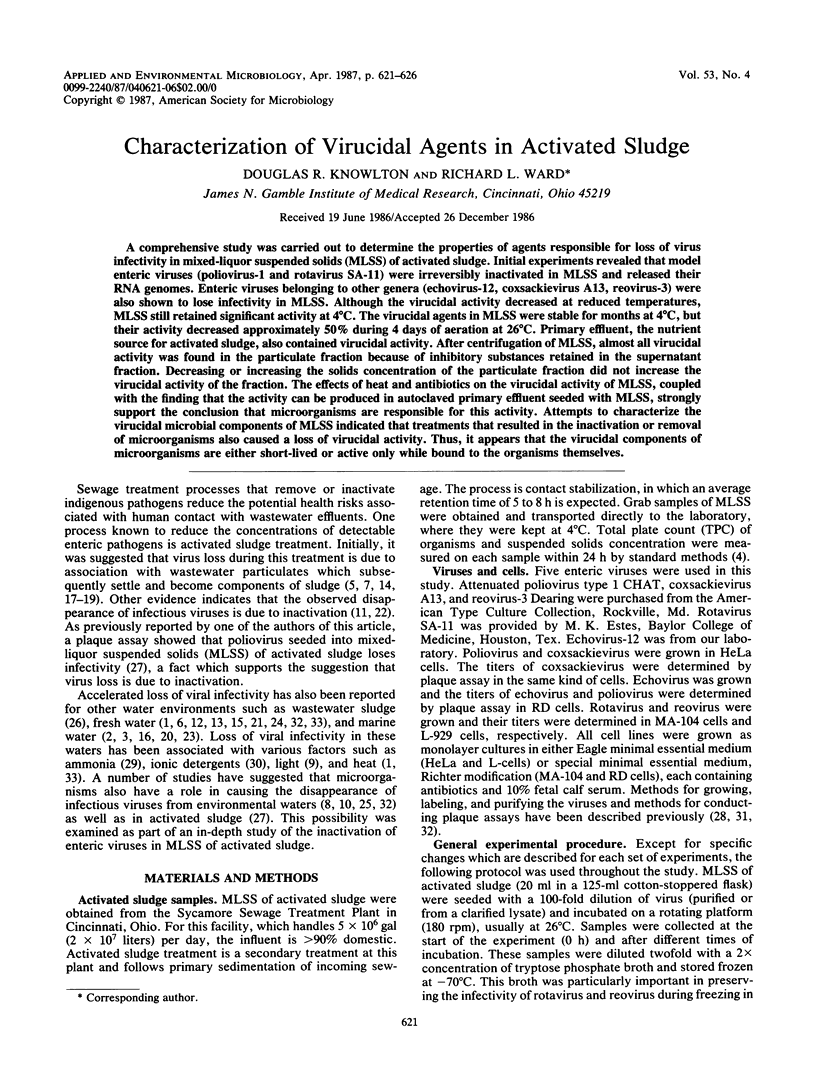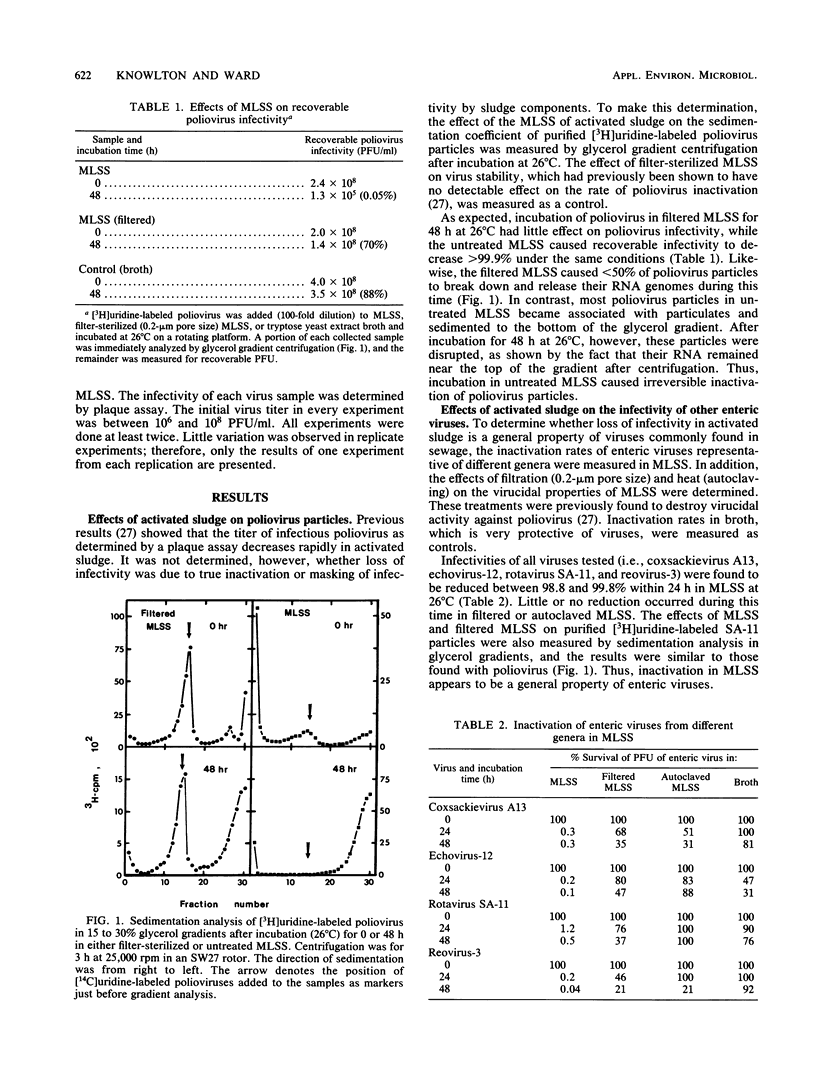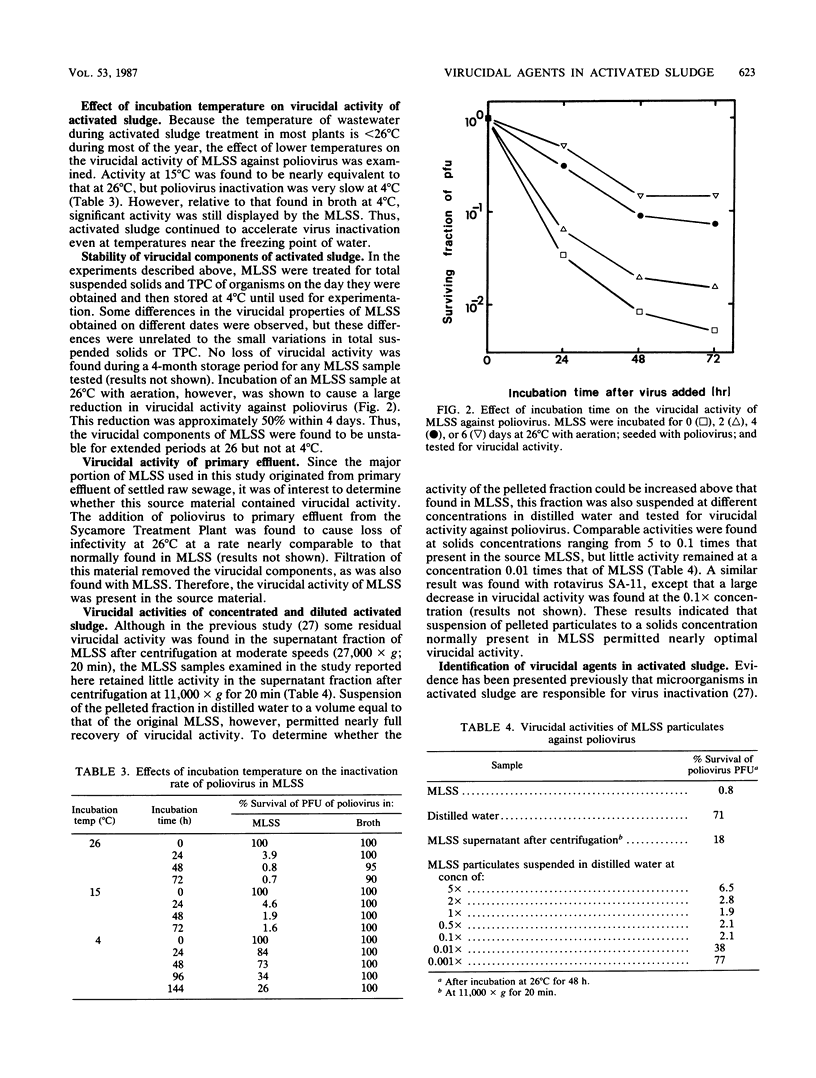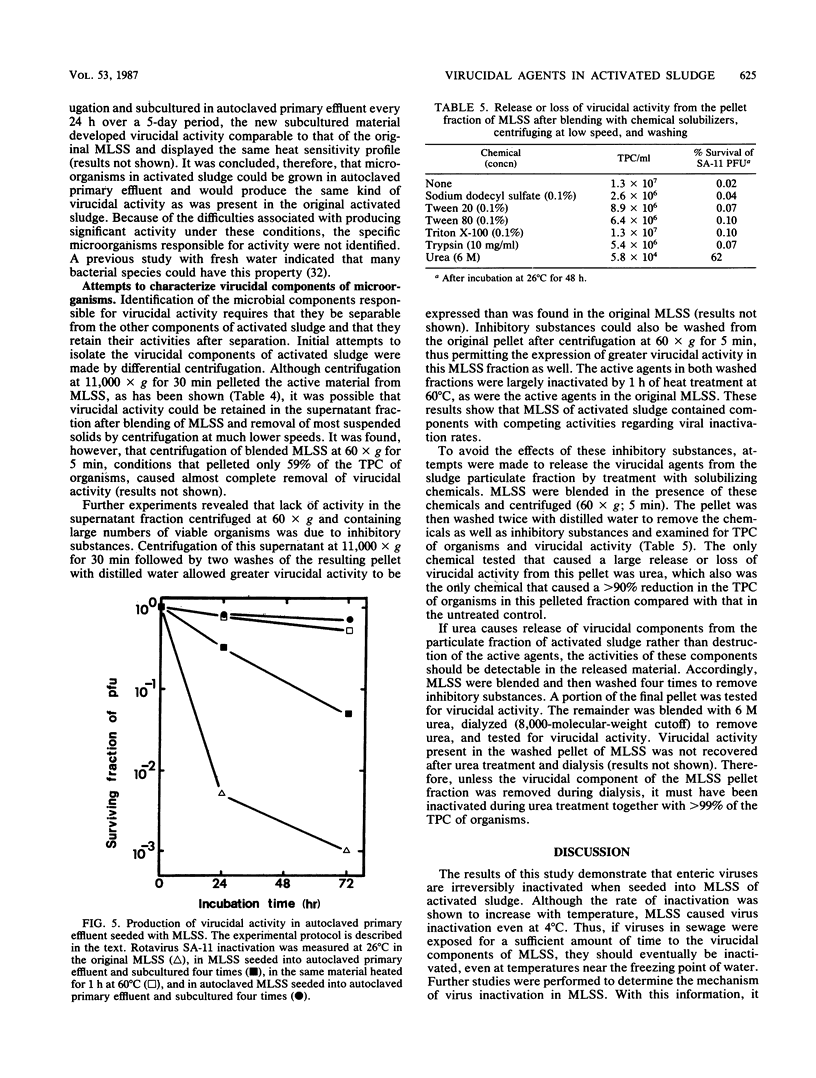Abstract
A comprehensive study was carried out to determine the properties of agents responsible for loss of virus infectivity in mixed-liquor suspended solids (MLSS) of activated sludge. Initial experiments revealed that model enteric viruses (poliovirus-1 and rotavirus SA-11) were irreversibly inactivated in MLSS and released their RNA genomes. Enteric viruses belonging to other genera (echovirus-12, coxsackievirus A13, reovirus-3) were also shown to lose infectivity in MLSS. Although the virucidal activity decreased at reduced temperatures, MLSS still retained significant activity at 4 degrees C. The virucidal agents in MLSS were stable for months at 4 degrees C, but their activity decreased approximately 50% during 4 days of aeration at 26 degrees C. Primary effluent, the nutrient source for activated sludge, also contained virucidal activity. After centrifugation of MLSS, almost all virucidal activity was found in the particulate fraction because of inhibitory substances retained in the supernatant fraction. Decreasing or increasing the solids concentration of the particulate fraction did not increase the virucidal activity of the fraction. The effects of heat and antibiotics on the virucidal activity of MLSS, coupled with the finding that the activity can be produced in autoclaved primary effluent seeded with MLSS, strongly support the conclusion that microorganisms are responsible for this activity. Attempts to characterize the virucidal microbial components of MLSS indicated that treatments that resulted in the inactivation or removal of microorganisms also caused a loss of virucidal activity. Thus, it appears that the virucidal components of microorganisms are either short-lived or active only while bound to the organisms themselves.
Full text
PDF





Selected References
These references are in PubMed. This may not be the complete list of references from this article.
- Berg G. Virus transmission by the water vehicle. II. Virus removal by sewage treatment procedures. Health Lab Sci. 1966 Apr;3(2):90–100. [PubMed] [Google Scholar]
- CLARKE N. A., STEVENSON R. E., CHANG S. L., KABLER P. W. Removal of enteric viruses from sewage by activated sludge treatment. Am J Public Health Nations Health. 1961 Aug;51:1118–1129. doi: 10.2105/ajph.51.8.1118. [DOI] [PMC free article] [PubMed] [Google Scholar]
- Fujioka R. S., Loh P. C., Lau L. S. Survival of human enteroviruses in the Hawaiian ocean environment: evidence for virus-inactivating microorganisms. Appl Environ Microbiol. 1980 Jun;39(6):1105–1110. doi: 10.1128/aem.39.6.1105-1110.1980. [DOI] [PMC free article] [PubMed] [Google Scholar]
- Herrmann J. E., Kostenbader K. D., Jr, CLIVER D. O. Persistence of enteroviruses in lake water. Appl Microbiol. 1974 Nov;28(5):895–896. doi: 10.1128/am.28.5.895-896.1974. [DOI] [PMC free article] [PubMed] [Google Scholar]
- Hurst C. J., Gerba C. P. Stability of simian rotavirus in fresh and estuarine water. Appl Environ Microbiol. 1980 Jan;39(1):1–5. doi: 10.1128/aem.39.1.1-5.1980. [DOI] [PMC free article] [PubMed] [Google Scholar]
- Lo S., Gilbert J., Hetrick F. Stability of human enteroviruses in estuarine and marine waters. Appl Environ Microbiol. 1976 Aug;32(2):245–249. doi: 10.1128/aem.32.2.245-249.1976. [DOI] [PMC free article] [PubMed] [Google Scholar]
- Magnusson S., Hedström C. E., Lycke E. The virus inactivating capacity of sea water. Acta Pathol Microbiol Scand. 1966;66(4):551–559. doi: 10.1111/apm.1966.66.4.551. [DOI] [PubMed] [Google Scholar]
- Mahnel H., Ottis K., Herlyn M. Stabilität von neun Virusarten unterschiedlicher Genera in Trinkund Oberflächenwasser. Zentralbl Bakteriol Orig B. 1977 Jan;164(1-2):64–84. [PubMed] [Google Scholar]
- Malina J. F., Jr, Ranganathan K. R., Sagik B. P., Moore B. E. Poliovirus inactivation by activated sludge. J Water Pollut Control Fed. 1975 Aug;47(8):2178–2183. [PubMed] [Google Scholar]
- Matossian A. M., Garabedian G. A. Virucidal action of sea water. Am J Epidemiol. 1967 Jan;85(1):1–8. doi: 10.1093/oxfordjournals.aje.a120666. [DOI] [PubMed] [Google Scholar]
- Nordöy A., Day H. J., Lund S. Subcellular localization of human platelet phospholipids and their fatty acid and aldehyde composition. Scand J Clin Lab Invest. 1969 Apr;23(2):169–174. doi: 10.3109/00365516909077021. [DOI] [PubMed] [Google Scholar]
- O'Brien R. T., Newman J. S. Inactivation of polioviruses and coxsackieviruses in surface water. Appl Environ Microbiol. 1977 Feb;33(2):334–340. doi: 10.1128/aem.33.2.334-340.1977. [DOI] [PMC free article] [PubMed] [Google Scholar]
- Ward R. L., Ashley C. S. Identification of detergents as components of wastewater sludge that modify the thermal stability of reovirus and enteroviruses. Appl Environ Microbiol. 1978 Dec;36(6):889–897. doi: 10.1128/aem.36.6.889-897.1978. [DOI] [PMC free article] [PubMed] [Google Scholar]
- Ward R. L., Ashley C. S. Identification of the virucidal agent in wastewater sludge. Appl Environ Microbiol. 1977 Apr;33(4):860–864. doi: 10.1128/aem.33.4.860-864.1977. [DOI] [PMC free article] [PubMed] [Google Scholar]
- Ward R. L., Ashley C. S. Inactivation of poliovirus in digested sludge. Appl Environ Microbiol. 1976 Jun;31(6):921–930. doi: 10.1128/aem.31.6.921-930.1976. [DOI] [PMC free article] [PubMed] [Google Scholar]
- Ward R. L. Evidence that microorganisms cause inactivation of viruses in activated sludge. Appl Environ Microbiol. 1982 May;43(5):1221–1224. doi: 10.1128/aem.43.5.1221-1224.1982. [DOI] [PMC free article] [PubMed] [Google Scholar]
- Ward R. L., Knowlton D. R., Pierce M. J. Efficiency of human rotavirus propagation in cell culture. J Clin Microbiol. 1984 Jun;19(6):748–753. doi: 10.1128/jcm.19.6.748-753.1984. [DOI] [PMC free article] [PubMed] [Google Scholar]
- Ward R. L., Knowlton D. R., Winston P. E. Mechanism of inactivation of enteric viruses in fresh water. Appl Environ Microbiol. 1986 Sep;52(3):450–459. doi: 10.1128/aem.52.3.450-459.1986. [DOI] [PMC free article] [PubMed] [Google Scholar]
- Yates M. V., Gerba C. P., Kelley L. M. Virus persistence in groundwater. Appl Environ Microbiol. 1985 Apr;49(4):778–781. doi: 10.1128/aem.49.4.778-781.1985. [DOI] [PMC free article] [PubMed] [Google Scholar]


